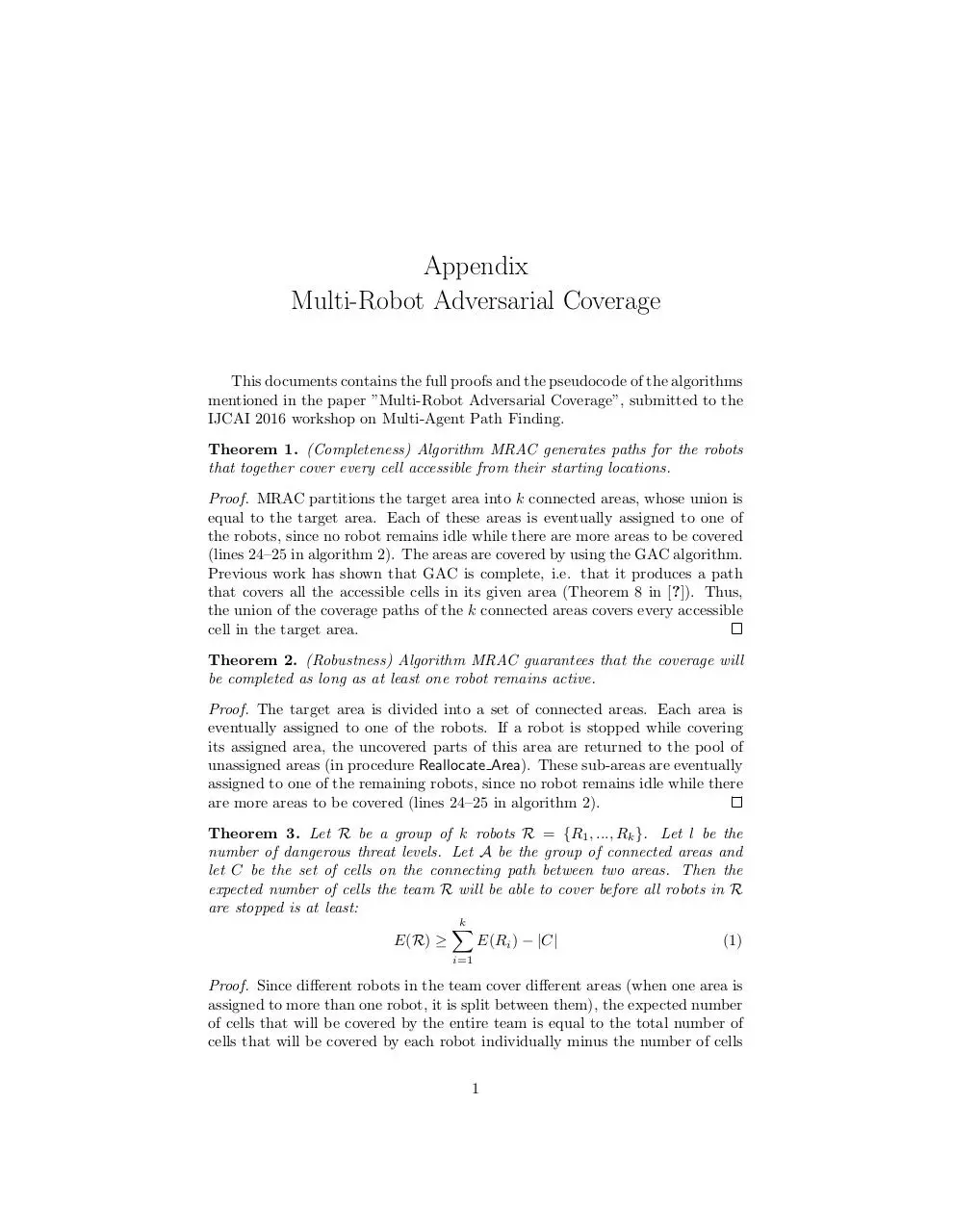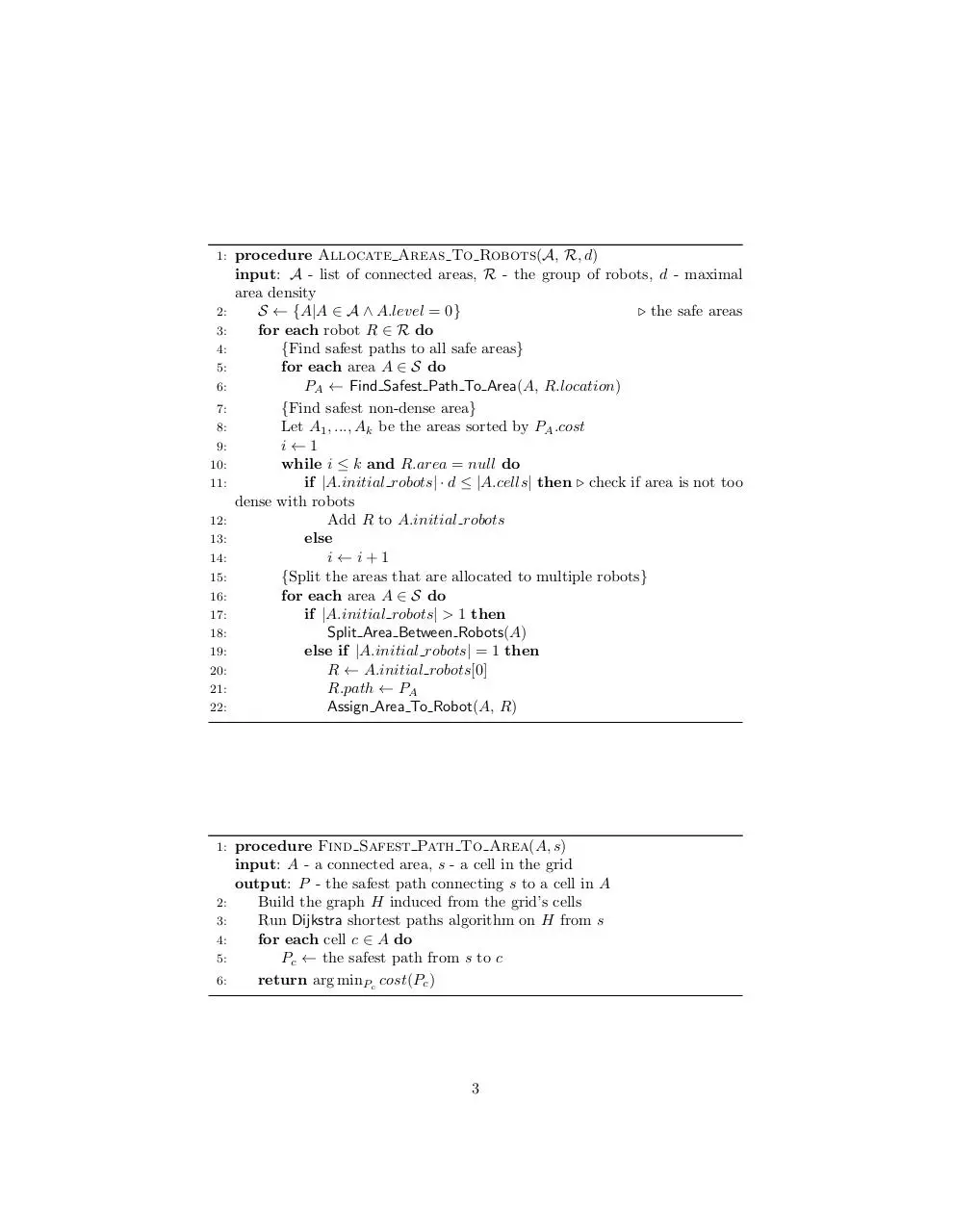MultiRobotAdversarialCoverageAppendix (PDF)
File information
This PDF 1.5 document has been generated by TeX / MiKTeX pdfTeX-1.40.13, and has been sent on pdf-archive.com on 19/04/2016 at 05:49, from IP address 77.126.x.x.
The current document download page has been viewed 477 times.
File size: 190.33 KB (8 pages).
Privacy: public file





File preview
Appendix
Multi-Robot Adversarial Coverage
This documents contains the full proofs and the pseudocode of the algorithms
mentioned in the paper ”Multi-Robot Adversarial Coverage”, submitted to the
IJCAI 2016 workshop on Multi-Agent Path Finding.
Theorem 1. (Completeness) Algorithm MRAC generates paths for the robots
that together cover every cell accessible from their starting locations.
Proof. MRAC partitions the target area into k connected areas, whose union is
equal to the target area. Each of these areas is eventually assigned to one of
the robots, since no robot remains idle while there are more areas to be covered
(lines 24–25 in algorithm 2). The areas are covered by using the GAC algorithm.
Previous work has shown that GAC is complete, i.e. that it produces a path
that covers all the accessible cells in its given area (Theorem 8 in [?]). Thus,
the union of the coverage paths of the k connected areas covers every accessible
cell in the target area.
Theorem 2. (Robustness) Algorithm MRAC guarantees that the coverage will
be completed as long as at least one robot remains active.
Proof. The target area is divided into a set of connected areas. Each area is
eventually assigned to one of the robots. If a robot is stopped while covering
its assigned area, the uncovered parts of this area are returned to the pool of
unassigned areas (in procedure Reallocate Area). These sub-areas are eventually
assigned to one of the remaining robots, since no robot remains idle while there
are more areas to be covered (lines 24–25 in algorithm 2).
Theorem 3. Let R be a group of k robots R = {R1 , ..., Rk }. Let l be the
number of dangerous threat levels. Let A be the group of connected areas and
let C be the set of cells on the connecting path between two areas. Then the
expected number of cells the team R will be able to cover before all robots in R
are stopped is at least:
k
X
E(R) ≥
E(Ri ) − |C|
(1)
i=1
Proof. Since different robots in the team cover different areas (when one area is
assigned to more than one robot, it is split between them), the expected number
of cells that will be covered by the entire team is equal to the total number of
cells that will be covered by each robot individually minus the number of cells
1
on the connecting paths between areas, since those might be visited multiple
times by different robots.
Theorem 4. The worst-case coverage time for k robots is equal to that of a
single robot and the best-case coverage time is approximately 1/k the coverage
time of a single robot.
Proof. The worst-case scenario is where all the robots start at locations that
are all inside dangerous areas, and thus they will be stopped by threats in the
beginning of their coverage paths. In such case, using more than one robot will
not improve the total coverage time. The best-case scenario is when the target
area consists of only one contiguous safe area (or a few large safe areas with
connecting paths that have very low risk). In such scenario, the area is split
into k almost equally-sized components that are covered concurrently by the k
different robots. In such scenario, the coverage time of MRAC highly depends
on the quality of the graph partitioning algorithm, which has no theoretical
guarantee, however, in practice, it almost always generated equally-sized subgraphs. The coverage time in this case also depends on the initial locations of
the robots, e.g., if the robots start the coverage at the same location, it will take
them some time to move to the their assigned areas.
We now provide the pseudocode of the algorithms.
Algorithm 1 Multi Robot Adversarial Coverage (MRAC)(G, R)
input: G - a grid representing the target area, R - group of k robots
output: A - list of connected areas
1: A ← ∅
2: Group the cells in G into l + 1 threat levels, T0 , ..., Tl
3: for each threat level i, 0 ≤ i ≤ l do
4:
Build the graph Hi induced from the cells in Ti
5:
Find the connected components (areas) of Hi using DFS
6:
Let A1 , ..., Ak be the connected areas of Hi
7:
for each area Aj , 1 ≤ j ≤ k do
8:
Aj .state ← Sunassigned
9:
Aj .level ← i
10:
Add Aj to A
11: Allocate Areas To Robots(A, R)
2
1:
2:
3:
4:
5:
6:
7:
8:
9:
10:
11:
12:
13:
14:
15:
16:
17:
18:
19:
20:
21:
22:
1:
2:
3:
4:
5:
6:
procedure Allocate Areas To Robots(A, R, d)
input: A - list of connected areas, R - the group of robots, d - maximal
area density
S ← {A|A ∈ A ∧ A.level = 0}
. the safe areas
for each robot R ∈ R do
{Find safest paths to all safe areas}
for each area A ∈ S do
PA ← Find Safest Path To Area(A, R.location)
{Find safest non-dense area}
Let A1 , ..., Ak be the areas sorted by PA .cost
i←1
while i ≤ k and R.area = null do
if |A.initial robots| · d ≤ |A.cells| then . check if area is not too
dense with robots
Add R to A.initial robots
else
i←i+1
{Split the areas that are allocated to multiple robots}
for each area A ∈ S do
if |A.initial robots| > 1 then
Split Area Between Robots(A)
else if |A.initial robots| = 1 then
R ← A.initial robots[0]
R.path ← PA
Assign Area To Robot(A, R)
procedure Find Safest Path To Area(A, s)
input: A - a connected area, s - a cell in the grid
output: P - the safest path connecting s to a cell in A
Build the graph H induced from the grid’s cells
Run Dijkstra shortest paths algorithm on H from s
for each cell c ∈ A do
Pc ← the safest path from s to c
return arg minPc cost(Pc )
3
1:
2:
3:
4:
5:
6:
7:
8:
9:
10:
11:
12:
13:
14:
15:
16:
17:
18:
19:
20:
1:
2:
3:
4:
5:
procedure Split Area Between Robots(A, R)
input: A - a connected area, R - the group of robots globals: A - list of
connected areas
Build the graph G induced from the area A’s cells
k ← |R|
Partition Graph(G, k)
Let G1 , G2 , ...Gk be the subgraphs created from the partition
for i ← 1 to k do
Create a subarea Ai
Ai .cells ← the nodes in Gi
Ai .level ← A.level
Add Ai to A
{Compute the safest path of each robot to the sub-area}
for j ← 1 to k do
Pij ← Find Safest Path To Area(Ai , Rj .location)
Cij ← Pij .cost
. the cost matrix
O ← Hungarian Method(C) . O is the optimal assignment of robots to
sub-areas
Oi ← optimal assignment of robot i
for i ← 1 to k do
Ri .path ← POi ,i
Assign Area To Robot(Oi , Ri )
Remove A from A
procedure Assign Area To Robot(A, R)
input: A - a connected area, R - a robot
A.robot ← R
A.state ← Sassigned
R.area ← A
R.state ← Straveling
4
Algorithm 2 Robot Action(R)
1: switch R.state do
2:
case Straveling
3:
c ← next cell on R.path
4:
Mark c as visited
5:
A ← the area that contains c
6:
if all cells in A are visited then
7:
A.state ← Scompleted
8:
if robot was hit by a threat in c then
9:
R.state ← Sdead
10:
Reallocate Area(R.area)
11:
else if c is the last cell on R.path then
12:
R.path ← Area Coverage(R.area, R.location)
13:
R.state ← Scovering
14:
case Scovering
15:
c ← next cell on R.path
16:
Mark c as visited
17:
if robot was hit by a threat in c then
18:
R.state ← Sdead
19:
Reallocate Area(R.area)
20:
else if c is the last cell on R.path then
21:
R.area.state ← Scompleted
22:
Allocate Next Area(R)
23:
case Sdone , Sidle
24:
if an unassigned area exists in A then
25:
Allocate Next Area(R)
26:
case Sdead
27:
R.area.state ← Sunassigned
5
1:
2:
3:
4:
5:
6:
7:
8:
9:
10:
11:
12:
13:
14:
15:
1:
2:
3:
4:
5:
6:
7:
8:
9:
10:
11:
12:
13:
14:
15:
procedure Allocate Next Area(R)
input: R - a robot
globals: A - the list of connected areas
U ← {A|A ∈ A ∧ A.state = Sunassigned }
if |U | > 0 then
{Allocate the safest unassigned area with the safest path from the
robot’s current location}
s ← minlevel U
S ← {A|A ∈ U ∧ A.level = s}
for each area A ∈ S do
PA ← Find Safest Path To Area(R, A)
A ← arg minA cost(PA )
R.path ← PA
Assign Area To Robot(A, R)
else
{If all the areas are assigned, find an area that the robot can help
covering}
if not Find Area To Share(R) then
R.state ← Sdone
procedure Allocate Next Area(R)
input: R - a robot
globals: A - the list of connected areas
U ← {A|A ∈ A ∧ A.state = Sunassigned }
if |U | > 0 then
{Allocate the safest unassigned area with the safest path from the
robot’s current location}
s ← minlevel U
S ← {A|A ∈ U ∧ A.level = s}
for each area A ∈ S do
PA ← Find Safest Path To Area(R, A)
A ← arg minA cost(PA )
R.path ← PA
Assign Area To Robot(A, R)
else
{If all the areas are assigned, find an area that the robot can help
covering}
if not Find Area To Share(R) then
R.state ← Sdone
6
1:
2:
3:
4:
5:
6:
7:
8:
9:
10:
11:
12:
13:
14:
15:
16:
17:
18:
19:
20:
21:
22:
23:
24:
25:
26:
27:
28:
1:
2:
3:
4:
5:
procedure Find Area To Share(R)
input: R - a robot
output: a flag indicating whether an area was found
globals: A - the list of connected areas
D ← {A|A ∈ A ∧ A.state = Sassigned }
for each area A ∈ D do
PA ← Find Safest Path To Area(R, A)
n ← number of unvisited cells in A
if |PA | > n then
Remove A from D
. no point of sending the robot there
if D = ∅ then return false
{Send the robot to the area with the safest path}
A ← arg minA cost(PA )
{Find the unvisited parts of the designated area}
Build the graph H induced from the unvisited cells in A
Find the connected components (areas) A1 , ..., Ak of H using DFS
if k = 1 then
{Split the area into two balanced parts}
Build the graph G induced from the area A’s cells
(G1 , G2 ) ← Partition Graph(G, 2)
Let A1 , A2 the two sub-areas induced from G1 , G2
{Replace the designated area with its unvisited parts}
Remove A from A
for each subarea Ai do
Ai .level ← A.level
Ai .state ← Sunassigned
Add Ai to A
{Reassign the robot covering area A to the part with the safest path
from its current location}
Assign Robot To Safest Area(Ai , A.robot)
Assign Robot To Safest Area(Ai , R)
return true
procedure Assign Robot To Safest Area(A, R)
input: A - group of connected areas, s - a robot
for each area A ∈ A do
PA ← Find Safest Path To Area(R, A)
A ← arg minA cost(PA )
Assign Area To Robot(A, R)
7
Algorithm 3 Area Coverage(A, c)
input: an area A, and a starting cell s
output: a coverage path P that covers all unvisited cells in A
1: P ← ∅
2: Build the graph H induced from A’s cells with the weight function w from
eq. (??)
3: Add the starting cell s to P
4: Mark s as visited
5: while there are unvisited cells in A do
6:
Run Dijkstra’s shortest paths algorithm on H from s
7:
v ← an unvisited node in A with minimum weighted distance from s
8:
Add the path s
v to P
9:
Mark v as visited
10:
s←v
11: return P
1:
2:
3:
4:
5:
6:
7:
8:
procedure Reallocate Area(A)
input: A - a connected area
globals: A - the list of connected areas, R - the group of robots
Build the graph H induced from the unvisited cells in A
Find the connected components (areas) A1 , ..., Ak of H using DFS
Remove A from A
for each subarea Ai do
Ai .level ← A.level
Ai .state ← Sunassigned
Add Ai to A
8
Download MultiRobotAdversarialCoverageAppendix
MultiRobotAdversarialCoverageAppendix.pdf (PDF, 190.33 KB)
Download PDF
Share this file on social networks
Link to this page
Permanent link
Use the permanent link to the download page to share your document on Facebook, Twitter, LinkedIn, or directly with a contact by e-Mail, Messenger, Whatsapp, Line..
Short link
Use the short link to share your document on Twitter or by text message (SMS)
HTML Code
Copy the following HTML code to share your document on a Website or Blog
QR Code to this page

This file has been shared publicly by a user of PDF Archive.
Document ID: 0000361839.